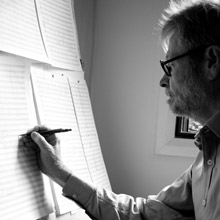Dawn Mantras for Live Performance
Ross Edwards composed Dawn Mantras especially for the Dawn Performance which was telecast to the world at the dawn of the new millennium from the Sydney Opera House. This work, which captivated an audience of billions, expresses hope for peace and renewal. A sequence of unforgettable images culminated in a young girl singing solo from the topmost of the building’s famous sails, accompanied by mixed choirs and a culturally diverse instrumental ensemble. The text was sourced from Latin, as well as living languages of Australia, South East Asia and the Pacific. The composer has recently devised a new range of performance possibilities for this iconic work and the material is now available for hire from Wise Music Group – Australia & New Zealand.
Ross Edwards writes:
When I composed Dawn Mantras, I designed it to be pre-recorded in a studio and mimed for live television performance. I hadn’t intended to release the score, nor had I anticipated the world-wide interest in the music which followed the telecast. In response to an increasing demand that the work be made available for live concert performance, accompaniment to dance, school speech days, large-scale ceremonial events associated with visits by spiritual leaders such as the Pope and the Dalai Lama, I’ve devised a format which I hope will facilitate performance and expand the range of possibilities.
In the original recording, two shakuhachis (Japanese bamboo flutes) were used to cover a range extending from G below middle C to C above the treble stave.
Although the sound of the shakuhachi is desirable, either an alto flute or clarinet would be an acceptable alternative (transposed parts are provided),as would a recorder.
The saxophone part may be played by either an alto or tenor instrument, or by a clarinet or cor anglais. A transposed part for each is provided.
The didjeridu opens the work with several lusty kookaburra imitations (to greet the dawn) and then retreats into the background as an underlying drone, freely rhythmic and occasionally rising to prominence.
Choir chimes are a most acceptable alternative to the crotali, and if the tuned gongs are unobtainable they may be replaced by two suspended cymbals or two tam-tams, one medium and one large.
It will be necessary, of course, to equalize the winds in performance. The shakuhachi in particular will need boosting, especially if – as in the original performance – it is paired with a tenor saxophone.
The vocal soloist must be able to produce top C clearly and accurately and should be a girl or boy, or a young woman capable of producing a pure, unforced sound throughout the range. Where possible, the soloist should perform from a high position, e.g., an organ loft.
Attention to lighting is encouraged – a gentle, white light appropriate to the dawn in an otherwise darkened space.


